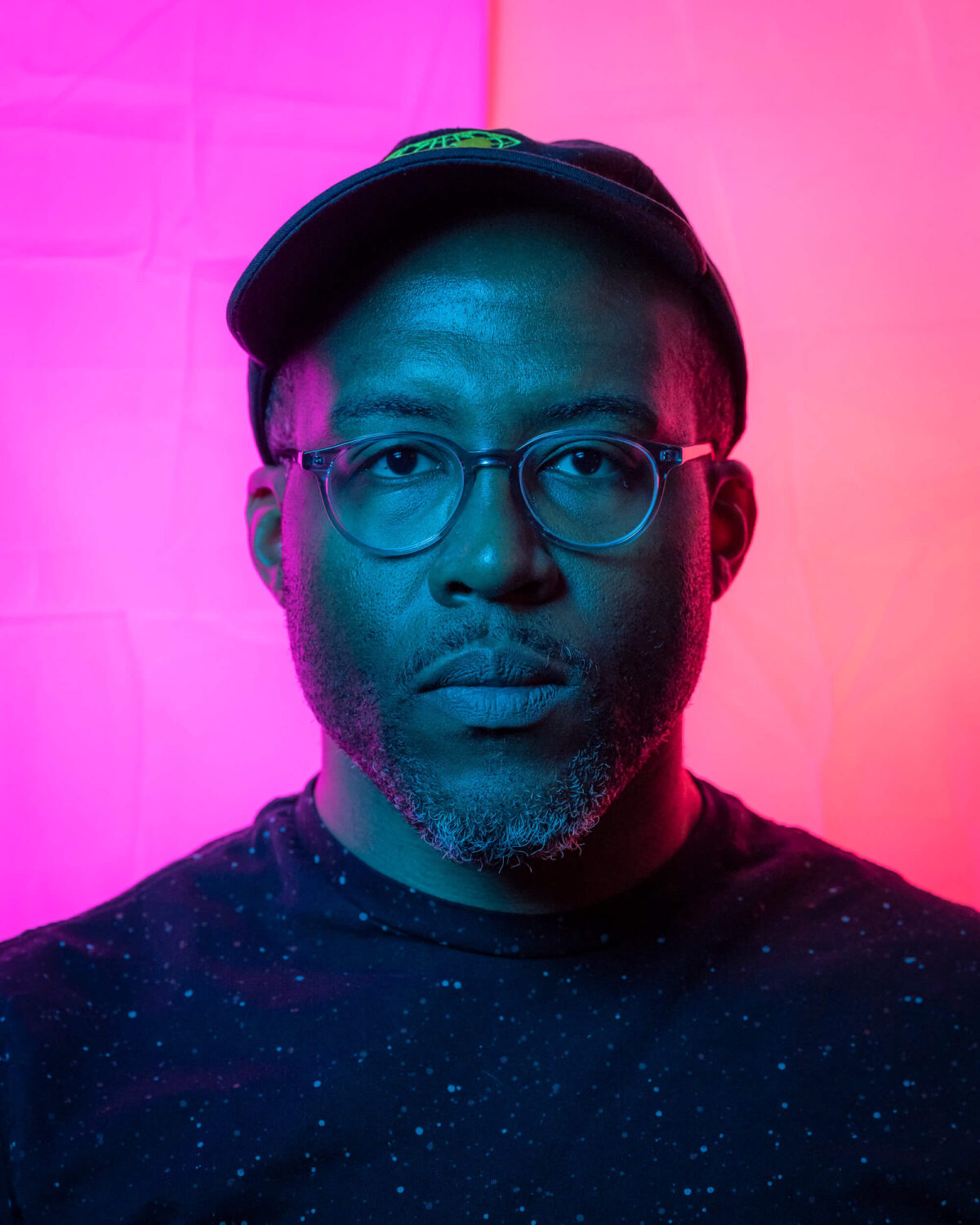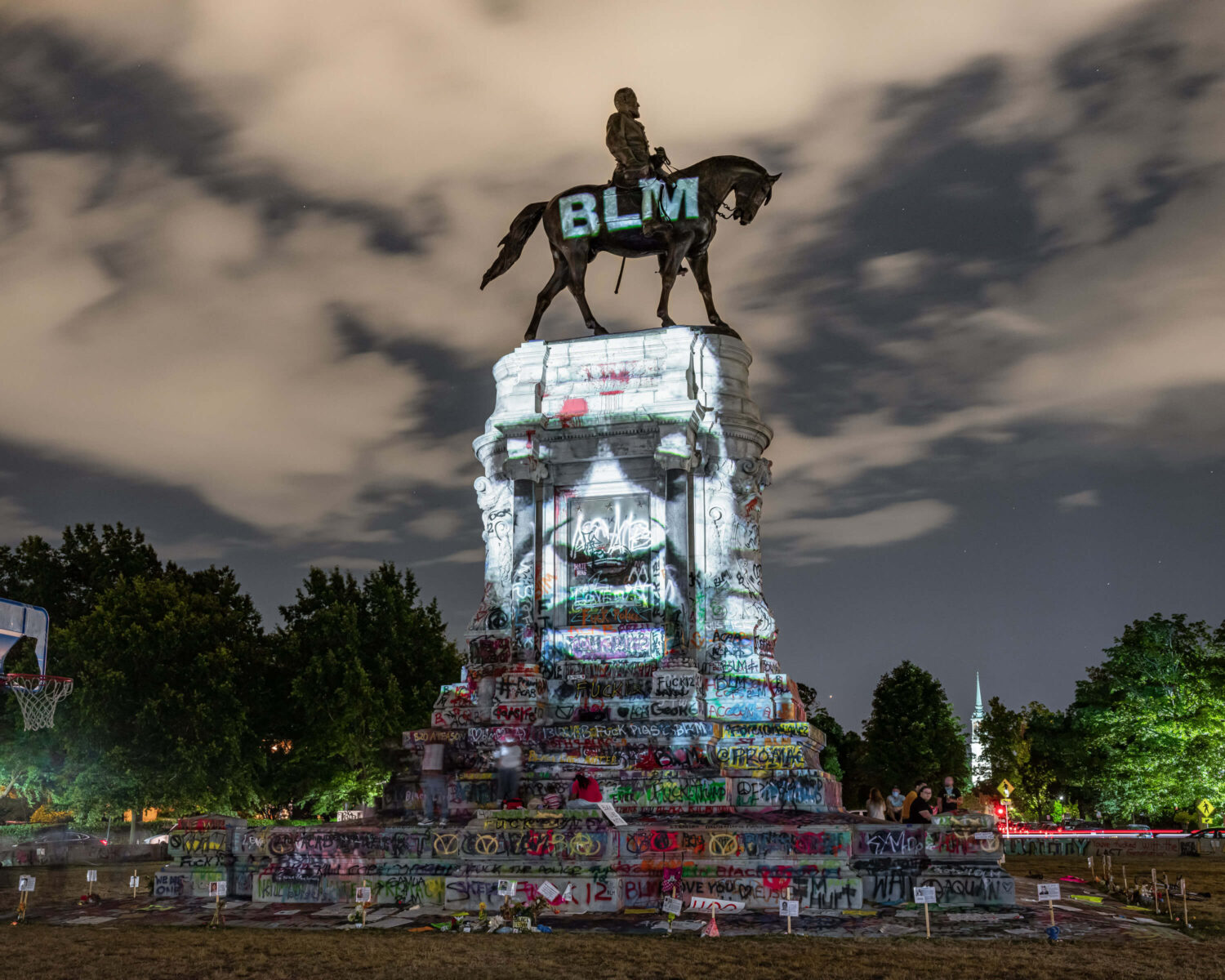
There is a photo from the height of the 2020 Black Lives Matter uprising in which George Floyd’s face is projected on the vandalized base of a Robert E. Lee statue in Richmond, Va., with large white “BLM” letters emblazoned on the former Confederate general’s horse. The photo, which was included in National Geographic’s “71 Photos from an Unforgettable Year” of 2020, is part of a larger project by photographer Kris Graves entitled Privileged Mediocrity. In this photo collection, Graves explores “systemic unfairness in the United States” and exposes “subtleties of societal power and its impact on the built environment of America and the construction of public and private space,” according to its synopsis.
While the photographs in Privileged Mediocrity do feature some faces—for instance, a Black man dressed as a colonial person in present-day Boston, or a sea of military service personnel—its images reveal Graves’ partiality to landscapes, where he says more “subtle stories” of racism, privilege, and inequality live: the place in the road where Michael Brown was killed by police in Ferguson, Mo., commemorated by flowers; a covered Tuskegee Confederate Monument; or the edifice of a high school named after General Lee.
It’s in this middle space between the abstract and the photojournalistic that Graves finds the most interesting photographers—a philosophy he’ll be carrying with him as a judge in PhotoMidwest 13th Biennial Exhibition presented by PhotoMidwest Festival 2024 and FlakPhoto Projects. The exhibition will run from September 17 to November 9 at the Arts + Literature Laboratory. Graves is tasked with curating an exhibition of photographs by over 60 Midwest photographers across 13 states.
Madison365 spoke with Graves ahead of his keynote address at the exhibit’s opening reception on September 27.

Rodlyn-mae Banting: How did you first get into photography?
Kris Graves: I went to school in Long Island for high school, right outside of New York City. My parents came from the city and moved out there. They were both artists in high school but in the 80s, you couldn’t really be a working artist. Because they were artists in their childhood, I think they allowed me to pursue that as something to go to college for. I always liked art more than every other subject in high school and middle school.
In middle high school, I realized that I wanted to do something in the arts. And the only art you can do by yourself and make money doing was photography. So luckily, our school had a dark room, and I was able to get the [photography] teacher to let me in early, learn darkroom stuff, and borrow the camera and start shooting. So that was it.
RB: I know that your work really explicitly makes political statements about race and capitalism. Do you understand photography to inherently be a political art form?
KG: Well, it gives itself to that, because you can make a picture in an instant, and these days you can push [a photo] out into the world pretty instantly. So yes, it becomes more political than a painting. It’s more likely for photographers not to be working in abstract versus other art forms. So it’s more about what you see in the world. For me, it hasn’t always been that way. Early on, I didn’t make pictures that were purposefully about politics or [I didn’t] really think they were about politics. [They were] more about social issues, which become politics. I’ve always been photographing the landscape and trying to relate [as I’m] going to a lot of different countries and different places where usually you don’t find many people of color.
But around 2014, I started to work a lot in American cities and portraiture of Black people. I’ve done some trips where I photographed where Black people were murdered by police officers, when a lot of [these killings were] happening on camera. I was photographing that a lot, and then moving into more subtle stories about gentrification, gerrymandering and other social conditions that happened to the landscape that aren’t really about [people’s portraits].
RB: Do you think that given its visual nature, photography allows folks to access or engage with issues in a different way than, say, writing would?
KG: Of course. I mean, I think both are great. And there’s a world where you need both of those things in combination to tell stories in more depth. If you have both a story that can be written and shown, then you can start to affect people’s truth. So for me, it’s part of a game. I don’t consider myself a photojournalist. I sometimes work in that field, but not usually. I’m usually working on art projects that deal with culture. I’m not making timely photographs.
RB: Another side of your work in the Kris Graves Projects (+KGP), your photobook press. What is the mission behind it?
KG: [When I was 25], I used to run a gallery in Brooklyn, and realized early on that no one I knew could afford the work that I was selling. I don’t care that much about trying to sell work in that way, personally. I thought that the way to get people’s hands on these projects that all these great photographers were making was to make books of that work and saying “If we can make a book that costs $40 or under, then maybe you’d be able to buy that.” So that’s kind of what the process was: “Hey, I have this whole project. You get all the images. It cost you 40 bucks.” That was a good deal. So we started KGP. Then [we started] collaborating with artists in about 2009 and started with three books, and went up to ten in a few years. And now we’ve made over 100 books.
Now we run that company as a photography book company, about culture and gender. We do a poetry and photography book every year. We work with queer folks all the time, every time. We want people to tell their stories. We don’t want to tell photojournalistic stories, we don’t want to tell abstract stories. We want something in the middle there that doesn’t have to be about something. We have a second press that we started in COVID named Monolith Editions. Those same principles apply, but it’s devoted to people of color. It’s not only photography, but work with artists of all disciplines.
RB: I was really struck by something you said in an interview with the MoMA where you said, “There’s no line between my personal work and what I publish.” Could you expand on that?
KG: All work is influenced by the work you see. It has to be better or worse. I work with museums now, but I worked at the Guggenheim Museum for eleven years while having that gallery, while starting the publishing company. So being influenced by all the work you see is kind of inevitable. Instead of steering clear of that, or trying to be my own person, collaborating with people helps me grow as an artist.
RB: You’re a judge for this year’s PhotoMidwest biennial exhibit. Could you talk about the kinds of photographs that you’re most drawn to?
KG: For competitions, it’s a little bit different because you have no idea what you’re gonna see, first off. It’s a challenge, but how I go into it is looking for pictures that bring something new to the table. Nothing’s brand new, but images that I think that a mass can enjoy. [The photos] being about a little bit about culture is helpful. For me, I always want to see that in the work because I look at a lot of photographs.
I know what I like. I know I can see what other people can do, meaning a lot of people can photograph a bird flying in the air. But what’s the purpose? If there’s no context to these simplistic photographs, it becomes pretty limited. Like any photograph, if it’s not telling me something that is memorable, or [something] I think people will remember, and not just photographers. The photography mindset that I have is very Northeast-based and has all the school stuff that I’ve gone through. I’m not from the Midwest. It’s a totally different mindset. I’m not really familiar with it, and I’m learning as I go. Photographs are universal but there are concerns that people outside of major cities have, so trying to deal with that and choose based on that is important for me—trying to broaden the horizons of photography. There’s about 50-60 images in the show, and there’s going to be a variety of different things, but I do think that it will make a concise group that can be placed in the same gallery and make sense.
RB: Is audience or reception a big consideration for you when you’re choosing photographs?
KG: For stuff like this, since it’s a show, it’s a big consideration. For personal work, it’s different. Making books is completely different. I do want the public to like the work because in some way they have to buy it and enjoy it. So the same thing [goes for] these artists in the show. I want to show the best these artists could do, and that’s the important part about these exhibitions. It’s a showcase for the best work you can make and I think everybody can grow from that. Especially being in a show this big, where there’s a lot of artists, hopefully a lot of artists come to the openings and see the show during, and they can be like, “Oh, that’s something I never saw or thought about before.” All the work that I’m around for [I make] for my mom and her to be like, “Oh, well that’s pretty interesting. That’s really cool.” I want people that do not know anything about photography to like the work, but I also want photographers to like the work.
RB: You’re doing a workshop here in Madison about the more entrepreneurial side of photography in addition to your keynote remarks. What would you say is the biggest piece of advice to photographers looking to do this as a career?
KG: I don’t know how many photographers can have a career in photography. It’s very difficult outside of major cities because there’s no clientele. But there’s artists everywhere. So I say that people should always learn how to photograph artwork, because that’s something that people need everywhere, and that’s something that in my career has been a solid foundation every month, photographing artwork for a museum or gallery or individuals. For me, it’s learning where you live. Can you be a photographer there? And if not, maybe you have to find a place that you can, unless you want to just go and do it yourself. There’s a lot of different ways to be a photographer. You can make it work, but it takes dedication and a lot of time—time to get good at the craft and to actually be solid with what you’re doing.



